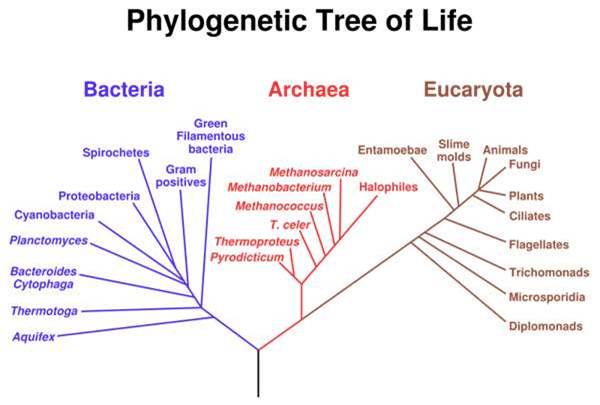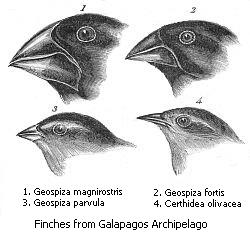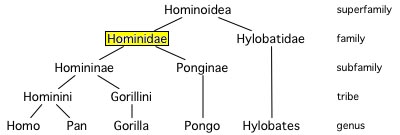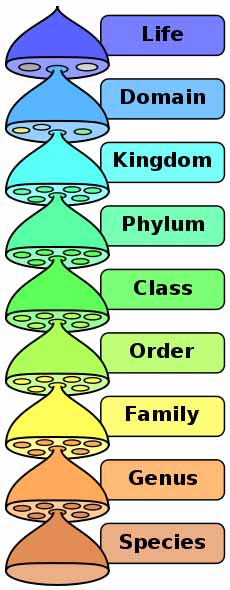 | ||||
Biological Systematics
Classification Meets Phylogeny
CLASS NOTES from Science Prof Online
Early scientists like Darwin, didn't have the modern technique of DNA sequencing to see how closely related organisms are, instead, living things were classified based on physical similarities and differences (like the finches beak shape). Today, modern systematics combines data from many sources, including the fossil record, comparative homologies (similarity of structures due to shared ancestry), and comparative sequencing of nucleic acids (DNA and RNA) among organisms.
There are two major areas that contribute to systematic biology:
- Biological Classification
- Phylogeny
Biological Classification
Classification is how biologists sort out different species into taxa, or biological categories, based on their evolutionary ancestry. Through this system, different species are hierarchically classified into increasingly specific groupings, species being the most specific.
Article Summary: Systematics is the classification of living things, based on their evolutionary relationships.
What Is Biological Systematics?
Portions of this article originally appeared on Suite101 online magazine.
Page last updated 9/2012
 | ||||
You have free access to a large collection of materials used in a college-level introductory microbiology course. The Virtual Microbiology Classroom provides a wide range of free educational resources including PowerPoint Lectures, Study Guides, Review Questions and Practice Test Questions.
The science of systematics involves putting living things into categories based on their evolutionary relationships; how closely related they are to each other. The goal is to compile a meaningful inventory of all living things; not merely to count how many different types of organisms there are. Looking at the patterns of similarity and differences in organisms can help us better understand how they are related and which arose from a common ancestor, information that biologists need when trying to understand the patterns of how life evolved. Here's an example.
Darwin's Galapagos Finches
When visiting the Galapagos Islands, a very isolated archipelago (cluster of islands) a place that many unusual animals call home, Charles Darwin observed that there were distinct types finches on the islands that, although similar in many ways, differed in the shape of their beaks, and, as a result, the type of food they could eat. In other words, each type of finch has a beak shape that made it a specialist at living in its own niche.
Darwin thought it was strange that there were so many slightly different types of finches on these small isolated islands, and he began to wonder if perhaps these slightly different birds had descended from a common ancestor that made the long journey to the Galapagos Islands many generations ago. Then the descendents of these ancestral finches diversified, over time, to exploit different food niches, reducing direct competition between the birds. This observation is one of the pieces of evidence that Darwin used to explain his theory of how living things evolve or change; natural selection.
What is a species? For sexually reproducing organisms, a species is a population that can breed and produce fertile offspring. For asexually reproducing organisms like bacteria, the species distinction is a little trickier.
The seven basic taxonomic categories are: Kingdom, Phylum, Class, Order, Family, Genus and Species; kingdom being the broadest category, and species being the most specific. The image to the right also includes the category of Domains (which consists of three groups Archaea, Eubacteria, Eukaryota), and all Life.
Students can use a simple mnemonic device to remember the order of these taxonomic categories. The sentence "King Philip came over for green soup" represents the order of taxonomic categories, from the most general to the most specific. For the expanded list on the above, this sentence can also be expanded to " Lazy, drunk King Philip came over for green soup."
What Is Phylogeny?
Binomial nomenclature does more than just allow for the naming of things. It also distinguishes closely related organisms from those that are less related. The genus name is shared by close relatives. For example, there were other members of the genus Homo, such as Homo habilis, Homo erectus, Homo antecessor and Homo ergaster. Modern humans just happen to be the only living member of the genus.
Members of the genus Pan (chimpanzees and bonobos) are less closely related to us than members of the genus Homo. The cladogram (tree of life) below shows the "branch" that includes humans and the other living things most closely related to us.
Taxonomy: What's In a Name?
Biological classification includes taxonomy, the naming and grouping of living things.
In order for biologists to be able to understand and communicate their knowledge about different life forms, organisms need to be named in a language that scientists from all around the world can understand. In the early days of scientific exploration the language that scientists had in common was Latin. So scientific names have a latinized format (meaning that they all sound like Harry Potter wizard spells when you say them).
In the 1700s, Carl Linnaeus, a Swedish biologist, introduced a two part naming system called binomial nomenclature. Every species discovered is assigned a genus and species name. The scientific name for modern humans is Homo sapiens, with Homo being our generic name, or genus, and sapiens being the specific, or species name.
So biological systematics employs both classification and knowledge of phylogeny to discover the relationships of all the amazing life forms on earth.
 | ||||||
You have free access to a large collection of materials used in a college-level introductory Cell Biology Course. The Virtual Cell Biology Classroom provides a wide range of free educational resources including Power Point Lectures, Study Guides, Review Questions and Practice Test Questions.
SPO VIRTUAL CLASSROOMS
 | ||||||
 | ||||||
SPO is a FREE science education website. Donations are key in helping us provide this resource with fewer ads.
Please help!
(This donation link uses PayPal on a secure connection.)







